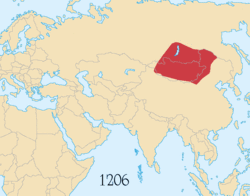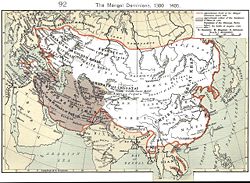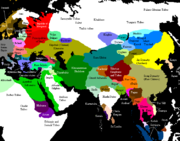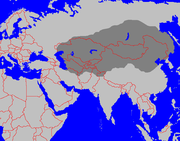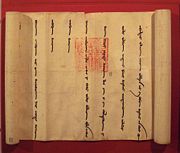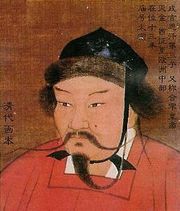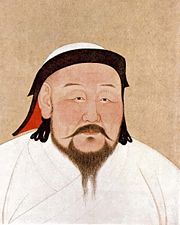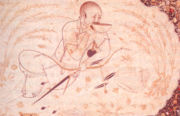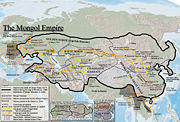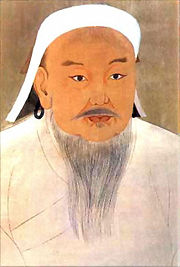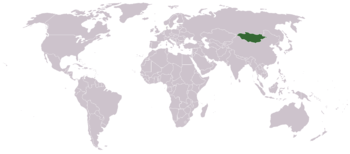Mongol Empire
2008/9 Schools Wikipedia Selection. Related subjects: Ancient History, Classical History and Mythology
|
|||||||||||||||||||||||||||||||||||||
The Mongol Empire ( Mongolian: Монголын Эзэнт Гүрэн , Mongolyn Ezent Güren or Их Mонгол улс, Ikh Mongol Uls; 1206–1405) was the largest contiguous empire and the second largest empire overall in world history. At its greatest extent it stretched from Moscow to the South China Sea. It emerged from the unification of Mongol and Turkic tribes in modern day Mongolia, and grew through invasions, after Genghis Khan had been proclaimed ruler of all Mongols in 1206.
By 1279, the Mongol Empire covered over 33,000,000 km² (12,741,000 sq mi), 22% of the Earth's total land area. It held sway over a population of over 100 million people. However, by that time the empire had already partly fragmented, with the Golden Horde and the Chagatai Khanate being de facto independent and refusing to accept Kublai Khan as Khagan. By the time of Kublai Khan's death, with no accepted Khagan in existence, the Mongol Empire became divided into four separate khanates.
Formation
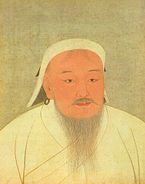
| History of Mongolia |
 |
| Before Genghis Khan |
| Mongol Empire |
| Khanates |
| - Chagatai Khanate |
| - Golden Horde |
| - Ilkhanate |
| - Yuan Dynasty |
| Timurid Empire |
| Mughal Empire |
| Crimean Khanate |
| Khanate of Sibir |
| Dzungar |
| Qing Dynasty ( Mongolia during Qing) |
| Republic of China |
| Mongolian People's Republic ( Outer Mongolia) |
| Modern Mongolia |
| Mengjiang ( Inner Mongolia) |
| People's Republic of China ( Inner Mongolia) |
| Buryat Mongolia |
| Kalmyk Mongolia |
| Hazara Mongols |
| Aimak Mongols |
| Timeline |
Genghis Khan, through political manipulation and military might, united the nomadic, previously ever-rivaling Mongol- Turkic tribes under his rule by 1206. He quickly came into conflict with the Jin Dynasty empire of the Jurchens and the Western Xia of the Tanguts in northern China. Under the provocation of the Muslim Khwarezmid Empire, he moved into Central Asia as well, devastating Transoxiana and eastern Persia, then raiding into Kievan Rus' (a predecessor state of Russia, Belarus and Ukraine) and the Caucasus. Before dying, Genghis Khan divided his empire among his sons and immediate family, but as custom made clear, it remained the joint property of the entire imperial family who, along with the Mongol aristocracy, constituted the ruling class.
Major events in the Early Mongol Empire
- 1206: Upon domination of Mongolia, Temüjin from the Orkhon Valley received the title Genghis Khan, thought to mean Universal Ruler or, Oceanic Ruler or Firm, Resolute Ruler
- 1207: The Mongols operations against the Western Xia, which comprised much of northwestern China and parts of Tibet. This campaign lasted until 1210 with the Western Xia ruler submitting to Genghis Khan. During this period, the Uyghur Turks also submitted peacefully to the Mongols and became valued administrators throughout the empire. The creation of classic mongolian script.
- 1211: Genghis Khan led his armies across the Gobi desert against the Jin Dynasty of northern China.
- 1218: The Mongols captured Zhetysu and the Tarim Basin, occupying Kashgar.
- 1218: The execution of Mongol envoys by the Khwarezmian Shah Muhammad set in motion the first Mongol westward thrust.
- 1219: The Mongols crossed the Jaxartes ( Syr Darya) and begin their invasion of Transoxiana.
- 1219–1221: While the campaign in northern China was still in progress, the Mongols waged a war in central Asia and destroyed the Khwarezmid Empire. One notable feature was that the campaign was launched from several directions at once. In addition, it was notable for special units assigned by Genghis Khan personally to find and kill Ala al-Din Muhammad II, the Khwarazm shah who fled from them, and ultimately ended up hiding on an island in the Caspian Sea.
- 1223: The Mongols gained a decisive victory at the Battle of the Kalka River, the first engagement between the Mongols and the East Slavic warriors.
- 1227: Genghis Khan's death; Mongol leaders returned to Mongolia for kuriltai. The empire at this point covered nearly 26 million km², about four times the size of the Roman or Macedonian Empires.
- 1229: Ogedei elected as Great Khan.
- 1232: The siege of Kaifeng. Missile- rockets were used by Jurcheds for the first time in world history.
- 1234: Mongols conquered Jurched Jin dynasty.
- 1236: Mongols invaded Korea and fully conquered northern regions of Koguryo. The beginning of Mongol invasion of Europe.
- 1236-1237: Mongol-Song war began.
- 1237: Under the leadership of Batu Khan, the Mongols returned to the West and began their campaign to subjugate Kievan Rus'
- 1236-1239: Mongol invasion of Georgia and Armenia under Chormaqan.
- 1240: Mongols sacked Kiev.
- 1241: Mongols defeated Hungarians and Croatians at the Battle of Sajo and Poles, Templars and Teutonic Knights at the Battle of Legnica.
- 1241: Ogodei khan's death.
- 1241 and 1242 Mongols under Batu and Khadan invaded Bulgaria and forced them to pay annual tribute as vassal.
- 1243: Western army made Seljuks of Anatolia a part of Mongol empire.
- 1246: Guyuk elected as Great khan.
- 1247: The first registration of the population of the empire.
- 1248: Great khan Guyuk died.
- 1251: Mongke, the elder son of Tolui, elected as Great khan.
- 1252: Mongol control over Yunnan.
- 1253: The first Mongol invasion of Dai Viet, Annam Vietnam. Mongols sacked an empty Thang Long, Hanoi. Deadly heat forced them to leave Vietnam.
- 1256: Hulagu exterminated the order of Hashshashins, whose leader known as Old man of the mountain. The foundation of Ilkhanate.
- 1258: Mongols occupied Baghdad. The fate of Abbasid caliphate.
- 1259: Mongol invasion of Syria. The death of Mongke.
- 1260: The battle of Ain Jalut. Mongol defeat to Mamluks.
Major events in the Late Mongol Empire
- 1260: Kublai Khan made Wonjong the king of Goryeo and helped stabilized his control over Korean peninsula.
- 1261: Two Great Khans in Mongol Empire: Kublai Khan and Ariq Boke. The succession war had begun, which marked the end of a united empire.
- 1262: Berke-Hulagu war
- 1264: Kublai won the supporters of Ariq Boke.
- 1269: The School of Mongolian language studies was established by Kublai khan's decree. Square script was introduced by Phagspa lama.
- 1271: The establishment of Yuan Dynasty and the National Academy of the empire.
- 1273: Paper money issued by the decree of Kublai khan.
- 1274: The first Mongol invasion of Japan.
- 1276: The fall of Song Dynasty.
- 1279: Mongols of Yuan Dynasty became supreme lords of all China.
- 1281: The second Mongol invasion of Japan.
- 1284: Failed second Mongol invasion of Vietnam.
- 1287: Pagan Kingdom falls to Mongols of Yuan dynasty who install a puppet king.
- 1288: Failed third Mongol invasion of Vietnam ( Battle of Bach Dang (1288)), which made Annam and Champa tributary vassals of Mongol Empire.
- 1292: Mongol raid on Java.
- 1294: Kublai Khan died. His grandson Oljeitu Temur was elected as his successor.
- 1304: Peace negotitation between Mongol khanates.
- 1310: Chapar, the son of Qaidu, submitted to the emperor of Yuan Dynasty. End of the wars between Mongol khanates.
- 1335: Last effective Ilkhan Abu Said died.
- 1368: Yuan Dynasty overthrown by Ming Dynasty.
Organization
Military setup
The Mongol military organization was simple, but effective. It was based on an old tradition of the steppe, which was a decimal system known in Iranian cultures since Achaemenid Persia, and later: the army was built up from squads of ten men each, called an arbat; ten arbats constituted a company of a hundred, called a zuut; ten zuuts made a regiment of a thousand called myanghan and ten myanghans would then constitute a regiment of ten thousand (tumen), which is the equivalent of a modern division.
Unlike other mobile-only warriors, such as the Xiongnu or the Huns, the Mongols were very comfortable in the art of the siege. They were very careful to recruit artisans and military talents from the cities they conquered, and along with a group of experienced Chinese engineers and bombardier corps, they were experts in building the trebuchet, Xuanfeng catapults and other machines with which they could lay siege to fortified positions. These were effectively used in the successful European campaigns under General Subutai. These weapons may be built on the spot using immediate local resources such as nearby trees.
Within a battle Mongol forces used extensive coordination of combined arms forces. Though they were famous for their horse archers, their lance forces were equally skilled and just as essential to their success. Mongol forces also used their engineers in battle. They used siege engines and rockets to disrupt enemy formations, confused enemy forces with smoke, and used smoke to isolate portions of an enemy force while destroying that force to prevent their allies from sending aid.
The army's discipline distinguished Mongol soldiers from their peers. The forces under the command of the Mongol Empire were generally trained, organized, and equipped for mobility and speed. To maximize mobility, Mongol soldiers were relatively lightly armored compared to many of the armies they faced. In addition, soldiers of the Mongol army functioned independently of supply lines, considerably speeding up army movement. Skillful use of couriers enabled these armies to maintain contact with each other and with their higher leaders. Discipline was inculcated in nerge (traditional hunts), as reported by Juvayni. These hunts were distinct from hunts in other cultures which were the equivalent to small unit actions. Mongol forces would spread out on line, surrounding an entire region and drive all of the game within that area together. The goal was to let none of the animals escape and to slaughter them all.
All military campaigns were preceded by careful planning, reconnaissance and gathering of sensitive information relating to the enemy territories and forces. The success, organization and mobility of the Mongol armies permitted them to fight on several fronts at once. All males aged from 15 to 60 and capable of undergoing rigorous training were eligible for conscription into the army, the source of honour in the tribal warrior tradition.
Another advantage of the Mongols was their ability to traverse large distances even in debilitatingly cold winters; in particular, frozen rivers led them like highways to large urban conurbations on their banks. In addition to siege engineering, the Mongols were also adept at river-work, crossing the river Sajó in spring flood conditions with thirty thousand cavalry in a single night during the battle of Mohi (April, 1241), defeating the Hungarian king Bela IV. Similarly, in the attack against the Muslim Khwarezmshah, a flotilla of barges was used to prevent escape on the river.
Law and governance
The Mongol Empire was governed by a code of law devised by Genghis, called Yassa, meaning "order" or "decree". A particular canon of this code was that the nobility shared much of the same hardship as the common man. It also imposed severe penalties – e.g., the death penalty was decreed if the mounted soldier following another did not pick up something dropped from the mount in front. On the whole, the tight discipline made the Mongol Empire extremely safe and well-run; European travelers were amazed by the organization and strict discipline of the people within the Mongol Empire.
Under Yassa, chiefs and generals were selected based on merit, religious tolerance was guaranteed, and thievery and vandalizing of civilian property was strictly forbidden. According to legend, a woman carrying a sack of gold could travel safely from one end of the Empire to another.
The empire was governed by a non-democratic parliamentary-style central assembly, called Kurultai, in which the Mongol chiefs met with the Great Khan to discuss domestic and foreign policies.
Genghis also demonstrated a rather liberal and tolerant attitude to the beliefs of others, and never persecuted people on religious grounds. This proved to be good military strategy, as when he was at war with Sultan Muhammad of Khwarezm, other Islamic leaders did not join the fight against Genghis — it was instead seen as a non-holy war between two individuals.
Throughout the empire, trade routes and an extensive postal system (yam) were created. Many merchants, messengers and travelers from China, the Middle East and Europe used the system. Genghis Khan also created a national seal, encouraged the use of a written alphabet in Mongolia, and exempted teachers, lawyers, and artists from taxes, although taxes were heavy on all other subjects of the empire.
At the same time, any resistance to Mongol rule was met with massive collective punishment. Cities were destroyed and their inhabitants slaughtered if they defied Mongol orders.
Religions
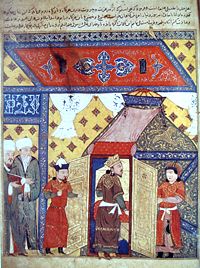
Mongols were highly tolerant of most religions, and typically sponsored several at the same time. At the time of Genghis Khan, virtually every religion had found converts, from Buddhism to Christianity and Manichaeanism to Islam. To avoid strife, Genghis Khan set up an institution that ensured complete religious freedom, though he himself was a shamanist. Under his administration, all religious leaders were exempt from taxation, and from public service.
Initially there were few formal places of worship, because of the nomadic lifestyle. However, under Ögedei, several building projects were undertaken in Karakorum. Along with palaces, Ogodei built houses of worship for the Buddhist, Muslim, Christian, and Taoist followers. The dominant religion at that time was Shamanism, Tengriism and Buddhism, although Ogodei's wife was a Christian. Later, three of the four principle khanates embraced Islam.
Buddhism
Ogedei's son and Guyuk's younger brother, Khoten (Хүдэн, Kötön), became the governor of Ningxia and Gansu. He launched a military campaign into Tibet under the command of Generals Lichi and Dhordha. The marauding Mongols burned down Tibetan monuments such as the Reting monastery and the Gyal temple in 1240. Prince Kötön was convinced that no power in the world exceeded the might of the Mongols. However, he believed that religion was necessary in the interests of the next life. Thus he invited Sakya Pandita to Mongolia. Prince Kötön was impressed by Sakya Pandita's teachings. Then he became the first known Buddhist prince of Mongol empire.
Khatun Chabi influenced Kublai to be converted to Buddhism. She received the Hévajra tantra initiations from Phagspa and was very impressed. Khubilai offered Phagpa rule over the thirteen trikhors of Tibet. On the completion of the second stage, Khubilai offered Phagpa a white dharma conch shell and rule over all the three provinces of Tibet. The third stage of the initiation was followed by Khubilai taking a vow to renounce the yearly mass sacrifices of his Chinese subjects. The sacrifices involved an annual ritual of throwing a large number of Chinese subjects into Lake Miyou to check the growth of the Chinese population in his empire.
Scientists says Hulagu and Abaqa were buddhists. And their religion flourished in Persia until Ghazan's reign. Tokhta of Golden Horde also encouraged lamas to settle in Russia.
Christianity
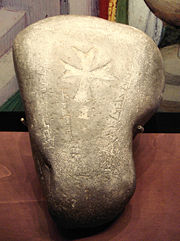
Some Mongols had been proselytized by Christian Nestorians since about the 7th century, and a few Mongols were converted to Catholicism, esp. by John of Montecorvino.
Some of the major Christian figures among the Mongols were: Sorghaghtani Beki, daughter in law of Genghis Khan, and mother of the Great Khans Möngke, Kublai, Hulagu and Ariq Boke; Sartaq, khan of Golden Horde; Doquz Khatun, the mother of the ruler Abaqa; Kitbuqa, general of Mongol forces in the Levant, who fought in alliance with Christians. Marital alliances with Western powers also occurred, as in the 1265 marriage of Maria Despina Palaiologina, daughter of Emperor Michael VIII Palaeologus, with Abaqa.
The 13th century saw attempts at a Franco-Mongol alliance with exchange of ambassadors and even military collaboration with European Christians in the Holy Land. The Nestorian Mongol Rabban Bar Sauma visited some European courts in 1287-1288. At the same time however, Islam began to take firm root amongst the Mongols, as those who embraced Christianity such as Tekuder, became Muslim.
Islam
Mongols employed many Muslims in various fields and increasingly took their advice in administrative affairs. Muslims became a favored class of officials as they were well educated and knew Turkish and Mongolian. Notable Mongol converts to Islam include Nogai Khan, Oljeitu, Tuda Mengu, Negudar and Berke who was the first Muslim leader of any the Mongol khanates.
Ghazan was the first Muslim khan to adopt Islam as national religion of Ilkhanate followed by Uzbek who urged his subjects to accept the religion as well. Though in Moghulistan, Mongols continued their nomadic lifestyle as Buddhism and shamanism flourished until the 1350's. While three out of the four Mongol khanates converted to Islam, Mongol men did not fully prohibit women's political influence.
Though the Yuan Dynasty was the only Khanate not to convert to Islam, there had been many Muslim foreigners since the khans were tolerant of other religions. Contact between Yuan emperors in China and Papal states and other Muslim states lasted until the mid-14th century. But Chingisid princes maintained contact with Muslims in Central Asia and Northwestern China so long during the post imperial period. According to Jack Weatherford, there were more than one million Muslims in Yuan Dynasty.
Tengerism (Shamanism)
Shamans which practics a form of animism with several meaning and with different characters, was popular religion in Ancient Central asia and Siberia. The central in the raltionship between humen and nature will be the worship of the Blue Mighty Eternal Heaven - "Blue Sky" (Хөх тэнгэр, Эрхэт мөнх тэнгэр). There are a total of 99 Tengris (sky-spirits) or Heavenly creatures in the lower and upper world. In which Köke Möngke Tengri (Eternal Blue Heaven) is the higest. He is the creator of the visible and invisible world. In the Asian mythologies it is referred to such as a monotheistic world with multiple Gods (Tengris, Burkhans and Lords). The next to Köke Möngke Tengri is the Qurmusata King.
There were famous shamans in Mongol Empire such as Teb tengri and Khorchi. And Most of early Great khagans except Kublai and khans of Golden Horde and Chagatai Khanate such as Batu, Tokhta, Chagatai, Duwa and Kebek were shamanists.
While Ghazan converted to Islam, he still practiced some elements of Mongol Shamanism. The Yassa code remained in place and Mongol Shamans were allowed to remain in the Ilkhanate empire and remained politically influential throughout his reign as well as Oljeitu's. However ancient Mongol shamanistic traditions went into decline with the demise of Oljeitu and with the rise of rulers practicing a purified form of Islam.
Trade networks
Mongols prized their commercial and trade relationships with neighboring economies and this policy they continued during the process of their conquests and during the expansion of their empire. All merchants and ambassadors, having proper documentation and authorization, traveling through their realms were protected. This greatly increased overland trade.
During the thirteenth and early fourteenth centuries, European merchants, numbering hundreds, perhaps thousands, made their way from Europe to the distant land of China — Marco Polo is only one of the best known of these. Well-traveled and relatively well-maintained roads linked lands from the Mediterranean basin to China. The Mongol Empire had negligible influence on seaborne trade.
Mail system
The Mongol Empire had an ingenious and efficient mail system for the time, often referred to by scholars as the Yam, which had lavishly furnished and well guarded relay posts known as örtöö set up all over the Mongol Empire. The yam system would be replicated later in the U.S. in the form of the Pony Express. A messenger would typically travel 25 miles (40 km) from one ordu to the next, and he would either receive a fresh, rested horse or relay the mail to the next rider to ensure the speediest possible delivery. The Mongol riders regularly covered 125 miles per day, which is faster than the fastest record set by the Pony Express some 600 years later.
Military conquests
Central Asia
Mongol invasion of Central Asia initially was composed of Genghis Khan's victory over and unification of the Mongol and Turkic central Asian confederations such as Merkits, Tartars, Mongols, Uighurs that eventually created the Mongol Empire. It then continued with invasion of Khwarezmid Empire in Persia.
Middle East
The Mongol invasion of the Middle East consists of the conquest, by force or voluntary submission, of the areas today known as Iran, Iraq, Syria, and parts of Turkey, with further Mongol raids reaching southwards as far as Gaza into the Palestine region in 1260 and 1300. The major battles were the Battle of Baghdad (1258), when the Mongols sacked the city which for 500 years had been the centre of Islamic power; and the Battle of Ain Jalut in 1260, when the Muslim Egyptian Mamluks, with some unusual provisioning assistance from the Christian European Crusaders, were for the first time able to stop the Mongol advance at Ain Jalut, in the northern part of what is today known as the West Bank.
Due to a combination of political and geographic factors, such as lack of sufficient grazing room for their horses, the Mongol invasion of the Middle East turned out to be the farthest that the Mongols would ever reach, towards the Mediterranean and Africa.
East Asia
Mongol invasion of East Asia refers to the Mongols 13th and 14th century conquests under Genghis Khan and his descendants of Mongol invasion of China, the invasion of Korea which forced Korea to become a vassal, and attempted Mongol invasion of Japan, and it also can include Mongols attempted invasion of Vietnam. The biggest conquest was the total invasion of China in the end.
Europe
Mongol invasion of Europe largely constitute of their invasion and conquest of Kievan Rus, much of Russia, invasion of Poland and Hungary among others.
Pope’s envoy to Mongol Khan Giovanni de Plano Carpini, who passed through Kiev in February 1246, wrote:
"They [the Mongols] attacked Russia, where they made great havoc, destroying cities and fortresses and slaughtering men; and they laid siege to Kiev, the capital of Russia; after they had besieged the city for a long time, they took it and put the inhabitants to death. When we were journeying through that land we came across countless skulls and bones of dead men lying about on the ground. Kiev had been a very large and thickly populated town, but now it has been reduced almost to nothing, for there are at the present time scarce two hundred houses there and the inhabitants are kept in complete slavery."
After Genghis Khan
At first, the Mongol Empire was ruled by Ögedei Khan, Genghis Khan's third son and designated heir, but after his death in 1241, the fractures which would ultimately crack the Empire began to show. Enmity between the grandchildren of Genghis Khan resulted in a five year regency by Ögedei's widow until she finally got her son Guyuk Khan confirmed as Great Khan. But he only ruled two years, and following his death -- he was on his way to confront his cousin Batu Khan, who had never accepted his authority -- another regency followed, until finally a period of stability came with the reign of Mongke Khan, from 1251-1259. The last universally accepted Great Khan was his brother Arigboh (aka. Arigbuga, or Arigbuha), his elder brother Kublai Khan dethroned him with his own supporters after some extensive battles. Kublai Khan ruled from 1260-1294. Despite his recognition as Great Khan, he was unable to keep his brother Hulagu and their cousin Berke from open warfare in 1263, and after Kublai's death there was not an accepted Great Khan, so the Mongol Empire was fragmented for good.
Genghis Khan divided his realm into four Khanates, subdivisions of a single empire under the Great Khan ( Khan of Khans). The following Khanates emerged after the regency following Ögedei Khan's death, and became formally independent after Kublai Khan's death:
- Blue Horde (under Batu Khan) and White Horde (under Orda Khan) would soon be combined into the Golden Horde, with Batu Khan emerging as Khan.
- Il-Khanate - Hulegu Khan
- Empire of the Great Khan (China) - Kublai Khan
- Mongol homeland (present day Mongolia, including Kharakhorum) - Tolui Khan
- Chagatai Khanate - Chagatai Khan
The empire's expansion continued for a generation or more after Genghis's death in 1227. Under Genghis's successor Ögedei Khan, the speed of expansion reached its peak. Mongol armies pushed into Persia, finished off the Xia and the remnants of the Khwarezmids, and came into conflict with the Song Dynasty of China, starting a war that concluded in 1279 with the conquest of populous China, which then constituted the majority of the world's economic production.
In the late 1230s, the Mongols under Batu Khan invaded Russia and Volga Bulgaria, reducing most of its principalities to vassalage, and pressed on into Eastern Europe. In 1241 the Mongols may have been ready to invade Western Europe as well, having defeated the last Polish-German and Hungarian armies at the Battle of Legnica and the Battle of Mohi. Batu Khan and Subutai were preparing to start with a winter campaign against Austria and Germany, and finish with Italy. However news of Ögedei's death spared Western Europe as Batu had to turn his attentions to the election of the next Great Khan. It is often speculated that this was one of the great turning points in history and that Europe may well have fallen to the Mongols had the invasion gone ahead. During the 1250s, Genghis's grandson Hulegu Khan, operating from the Mongol base in Persia, destroyed the Abbasid Caliphate in Baghdad and destroyed the cult of the Assassins, moving into Palestine towards Egypt. The Great Khan Möngke having died, however, he hastened to return for the election, and the force that remained in Palestine was destroyed by the Mamluks under Saif ad-Din Qutuz in 1261 at Ayn Jalut.

Vassals
The Mongol Empire included China, most of Russia, Siberia, parts of Burma, and all of Georgia, Armenia, Cilicia, Anatolia, Iraq, Persia, Central Asia, Ukraine and Belarus.
European vassals
- Kingdom of Lithuania, the nominal vassal. However, Mongols under Orda and Burundai successfully invaded southern regions of Lithuania in 1241 and in 1259 (Later Nogai), the grand duke Jogaila officially acknowledged Tokhtamysh as overlord in 1382. Mongols of Golden Horde always counted Lithuanians as a part of their subjects, but there is no evidence of a tributary relationship between them.
- A number of Russian states, incl. the Republic of Novgorod, Pskov Batu khan could not reach northern part of Russia due to the marshlands surrounding city-states such as Novgorod and Pskov in 1239. But combined effects of Alexander Nevsky's diplomacy, Mongol threats and Teutonic order invasion, forced Novgorod and later Pskov accepted the term of vassalage. According to book "Mongol-tatars in Asia & Europe" (Монгол-Татарууд Ази Европт) by Mongolian and Russian scientists, Bichigechi Berkhchir who was an envoy of Kublai khan had worked Novgorod for a while.
- Second Bulgarian Empire During the end of Mongol invasion of Europe, Balkan bulgars tried to destroy Mongol tumen. But Kadan's raids through Bulgaria on his retreat from Central Europe induced the young Kaliman I of Bulgaria to pay tribute and accept Mongol suzerainty. According to a letter of Bela IV to the pope written in 1254 indicates that at that time the Bulgarians were still paying tribute to the Mongols.
- Kingdom of Serbia. Around 1288 Milutin launched an invasion to pacify two Bulgarian nobles in today's north-east Serbia, in the Branicevo region, but those nobles were vassals of the Bulgarian prince of Vidin Shishman. Shishman attacked Milutin but was defeated and Milutin in return sacked his capital Vidin. But Shishman was a vassal of Nogai Khan, de facto ruler of the Golden Horde. Nogai Khan threatened to punish Milutin for his insolence, but changed his mind when the Serbian king sent him gifts and hostages. Among the hostages was his son Stefan Dečanski who managed to escape back to Serbia after Nogai Khan's death in 1299.
Southeast Asian vassals
- Annam
- Champa
- Khmer empire
- Sukhotai
Middle East vassals
- The principality of Antioch and Tripoli.
The small crusader state paid annual tributes for many years.The closest thing to actual Frankish cooperation with Mongol military actions was the overlord-subject relationship between the Mongols and the Franks of Antioch and others.
- Empire of Trebizond
The Seljuks and the military forces of Trebizond were defeated by the Mongols in 1243 . After that, Kaykhusraw II, the Sultan of Iconium was compelled to relieve himself by paying tribute and supplying annually horses, hunting dogs, and jewels. The emperor Manuel I of Trebizond, realizing the impossibility of fighting the Mongols, made a speedy peace with them and, on condition of paying an annual tribute, became a Mongol vassal. The empire reached its greatest prosperity and had opportunity to export the produce of its own rich hinterland during the era of Ilkhans. But with the decline of Mongol power in 1335, Trebizond suffered increasingly from Turkish attacks, civil wars, and domestic intrigues.
Tributary states
- Small states of Malay
- Goryeo, present day Korea
- Byzantine empire. In the winter of 1265 Nogai led a Mongol raid on Byzantine Thrace with his vassal Balkan bulgars. In the spring of 1265 he defeated the armies of Michael VIII Palaeologus. Instead of fighting, most of the Byzantines fled due to powerful Mongol army. Michael managed to escape with the assistance of Italian merchants. After this Thrace was plundered by Nogai's army, and the Byzantine emperor signed a treaty with Berke khan of Golden Horde, giving his daughter Euphrosyne in marriage to Nogai. Michael also sent much valuable fabric to the Golden Horde as a tribute thereafter.
Areas that avoided Mongol conquest
Essentially, only five areas accessible to the Mongols avoided conquest by them -- Indochina, South Asia, Japan, Western Europe and Arabia. Also, two important cities that evaded the Mongol Conquest were Vienna and Jerusalem. Both evaded the conquest because of the death of a Great Khan.
Western Europe
While the Mongolian Empire extended into Poland and threatening present day Austria, the Mongols were not able to push into Western Europe. The most popular explanation was the fact that on 11 December 1241, during pre-emptive operations by Mongol reconnaissance forces inside Austria for the invasion of Vienna, news came that Ogedei Khan died, and bound by Mongol tradition, all Mongol commanders and princes had to report back to the capital of Karakorum to elect a new Khan. It was believed that the Mongol abandonment of the European campaign was only temporary, but in fact, the Mongols had committed no further campaigns into Europe in earnest. Some western historians attribute European survival to Mongol unwillingness to fight in the more densely populated German principalities, where the wetter weather affected their bows. But the same weather did not stop them from devastating Russia or the campaigns against the Southern Song, and Europe was less densely populated than China.
The probable answer for the Mongol's stopping after the Mohi River, and the destruction of the Hungarian army, was that they never intended to advance further at that time.
Batu Khan had made his Russian conquests safe for the next 10 generations, and when the Great Khan died, he rushed back to Mongolia to put in his claim for power. Upon his return, relations with his cousin Guyuk Khan had deteriorated to the point that open warfare between them came shortly after Guyuk's death. The point is that the Mongols were unable to bring a unified army to bear on either Europe, or Egypt, after 1260. Batu Khan was in fact planning invasion of Europe all the way to the "Great Sea" — the Atlantic Ocean, when he died in 1255.
His son inherited the Khanate, but also died in a short time, and Batu's brother Berke became Khan of the Kipchak Khanate. He was far more interested in fighting with his cousin Hulagu than invading the remainder of Europe, which was no threat to him.
Vietnam and Japan
Another area not conquered by Mongols was Vietnam under the Trần Dynasty, which repelled Mongol attacks in 1257/1258, 1284/1285 and 1287/1288.
But around 1288, Annam and Champa started to pay tributary to the emperors of the Yuan Dynasty. That is why the two states of Vietnam are considered vassals of the Mongol Empire.
Japan also repelled massive Mongol invasions in 1274 and 1281. Japan's ruler Hojo Tokimune first sent back the emissaries time and time again without audience in Kamakura, and then after the first invasion was so bold as to behead Kubilai's emissaries, twice. In both Japan and Vietnam, Kublai sent part of the Mongol armies, instead of concentrating on Vietnam first, and then Japan. Furthermore, the splitting of resources left the Mongols with a fleet that was not readily equipped for the storms that plagued the Sea of Japan. A great storm sank the primary invasion fleet and killed most of the Mongol army during the 1281 invasion.
Southeast Asia
Many other kingdoms in Indochina could counter the Mongol invasion, such as the Maoluang Kingdom (or Kingdom of Mong Mao) in Northern Thailand, Shan and Kachin in today's Northern and Northeastern Myanmar as well as Assam in Eastern India and Southwestern China. Sa Khaan Pha (or Si Ke Fa), king of Maoluang Kingdom, was able to negotiate a treaty after he defeated the Mongols three times during the period of Kublai Khan. He received authority over the land south of the Sang city which is now Kunming in the Yunnan province of China. Mongol-led Yuan forces attacked Champa in Southern Vietnam with large scale of army once in 1287. Lanna and Sibsongpanna (in present Northern Thailand, Northern Laos and Southern China), Lan Xang (in present Laos), the Siamese kingdoms of Chiang Saen (or Chieng Saeng), Lavo, Haripunjai, Phyao and Sukhotai never invaded by the Mongols due to the rough terrain. However, the Burmese Pagan dynasty was destroyed in 1287 by Kublai Khan as well as the Northern Vietnamese empire of Viet. Sodu sent also 100 Mongols to raid on Khmer Empire while he was fighting with Champa. But Yuan later made most of Southeast Asian states tributary vassals somehow except Java where they failed.
South Asia
South Asia was also able to withstand the advance of the Mongols. At this time, Northern India was under the rule of the Delhi sultanate. Though the Mongols raided into the Punjab and besieged Delhi itself (unsuccessfully), the Sultans--mostly notably Ghiyasuddin Balban--were able to keep them at bay and roll them back. Historian John Keay credited the successful combination of the Indian elephant phalanx and maneuverable central Asian cavalry operated by the rulers of Northern India. Ironically, 300 years later, Babar, a Timurid scion who claimed descent from Genghis Khan, would go on to conquer northern India and found the Mughal Empire.
Arabia and Egypt
The final area which would withstand the Mongols was the Levant. The Mamluks successfully defended the Holy Land with the aid of Berke Khan who allied himself with them after his cousin enraged him by sacking Baghdad, (Berke was a Muslim, and sent word to the Great Khan that he would "call him to account ( Hulagu Khan), for he has murdered the Caliph in Baghdad, and killed all the faithful.") This Mongol against Mongol fighting, after the Mamluks defeated the Mongols at Ain Jalut in 1260 ultimately brought down the Mongol Empire. Mamluks also repelled Mongol attacks in Syria in 1271, 1281, 1299/1300, 1303/1304 and 1312.
Disintegration
When Genghis Khan died, a major potential weakness of the system he had set up manifested itself. It took many months to summon the kurultai, as many of its most important members were leading military campaigns thousands of miles from the Mongol heartland. And then it took months more for the kurultai to come to the decision that had been almost inevitable from the start — that Genghis's choice as successor, his third son Ögedei, should become Great Khan. Ögedei was a rather passive ruler and personally self-indulgent, but he was intelligent, charming and a good decision-maker whose authority was respected throughout his reign by apparently stronger-willed relatives and generals whom he had inherited from Genghis.
After the initial massive campaigns at the beginning of the conquest of Europe, where the Mongol war machine handily defeated the Hungarian and Polish armies, the Hospitallers, the Teutonic Knights, as well as the slaughtering of countless many civilians, Ögedei Khan suddenly died in 1241; just as the Mongol forces under General Subutai were preparing an all out assault on Vienna, Austria. This sudden vacuum of power is seen as the beginning of the events that led to the decline of the Mongol Empire. As customary to Mongol military tradition, all generals and princes, and thus the tumens, had to report back to the capital Karakorum thousands of miles away (the relocation of the capital to Dadu would add to this difficulty under Kublai Khan), for the election of a successor to the throne. Pending a kurultai to elect Ögedei's successor, his widow Toregene Khatun assumed power and proceeded to ensure the election of her son Guyuk by the kurultai. Batu, bitterly disappointed by the postponement of the European campaign, was unwilling to accept Guyuk as Great Khan, but lacked the influence in the kurultai to procure his own election. Therefore, while moving no further west, he simultaneously insisted that the situation in Europe was too precarious for him to come east and that he could not accept the result of any kurultai held in his absence. The resulting stalemate lasted four years. In 1246 Batu eventually agreed to send a representative to the kurultai but never acknowledged the resulting election of Guyuk as Great Khan. Toregene Khatun and Guyuk were also less in favour of the Mandarin officials installed by Genghis Khan himself, most notably Chancellor Yeh-Lu Ch'u-Ts'ai, who were so instrumental in the successful administration of Mongol conquests, choosing instead, to place Muslim administrators from the new domains to help run Mongol politics.
Guyuk died in 1248, only two years after his election, on his way west, apparently to force Batu to acknowledge his authority, and his widow Oghul Ghaymish assumed the regency pending the meeting of the kurultai; unfortunately for her, she could not keep the power. Batu remained in the west but this time gave his support to his and Guyuk's cousin, Möngke, who was duly elected Great Khan in 1251.
Möngke Khan assigned his brother Kublai, or Qubilai, to a province in North China, which would unwittingly provide Kublai with a chance to become Khan in 1260 shortly after Möngke's death in 1259.
Kublai expanded the Mongol Empire and became a favorite of Möngke. Kublai's conquest of China is estimated by Holworth, based on census figures, to have killed over 18 million people. As pointed out by Rummel, these figures are probably highly exaggerated, although a large number of people died in the course of the conquest.
Later, though, when Kublai began to adopt many Chinese laws and customs, his brother was persuaded by his advisors that Kublai was becoming too sinicized and would be considered treasonous. Möngke kept a closer watch on Kublai from then on but died campaigning against Southern Song China at the Fishing Town in Chongqing. After his older brother's death, Kublai placed himself in the running for a new khan against his younger brother, and, although his younger brother won the election, Kublai defeated him in battle, and Kublai became the last Great Khan. Note, among historians there is no consensus who was the last true Great Khan. Many scholars believe that Möngke was the last, because after his death, the great empire fell apart into 4 khanates.
He proved to be a strong warrior, but his critics still accused him of being too closely tied to Chinese culture. When he moved his headquarters to Beijing, there was an uprising in the old capital that he barely staunched. He focused mostly on foreign alliances, and opened trade routes. He dined with a large court every day, and met with many ambassadors, foreign merchants, and even offered to convert to Christianity if this religion was proved to be correct by 100 priests.
By the reign of Kublai Khan, the empire was already in the process of splitting into a number of smaller khanates. After Kublai died in 1294, his heirs failed to maintain the Pax Mongolica effective. Inter-family rivalry compounded by the complicated politics of succession, which twice paralyzed military operations as far off as Hungary and the borders of Egypt (crippling their chances of success), and the tendencies of some of the khans to drink themselves to death fairly young (causing the aforementioned succession crises), hastened the disintegration of the empire.
Another factor which contributed to the disintegration was the difficulty of the potential two-weeks extra transit time of officials and messengers and a general decline of morale when the capital was moved from Karakorum to Dadu, the Yuan name for the modern day city of Beijing by Kublai Khan; as Kublai Khan associated more closely to Chinese culture. Kublai concentrated on the war with the Song Dynasty, assuming the mantle of ruler of China, while the khanates to the west gradually drifted away.
The four descendant empires were the Mongol-founded Yuan Dynasty in China, the Chagatai Khanate, the Golden Horde that controlled Central Asia and Russia, and the Ilkhanate that ruled Persia from 1256 to 1353. The conflict between Kublai Khan and the khanates in Central Asia led by Kaidu (Qaidu) had lasted for a few decades, until the beginning of the 14th century, when both of them had died. Of the Ilkhanate, their ruler Ilkhan Ghazan was converted to Islam in 1295 and renounced all allegiance to the Great Khan. He actively supported the expansion of this religion in his empire. The Mongol Empire was never again under one rule, though the other three khanates negotiated peace with Temür Khan of Yuan Dynasty and acknowledged him as their nominal overlord in 1304, in order to maintain trade and diplomatic relations. During 1330's, Bishop (probably Hungarian) from Soltaniyeh described their relationship in his letter to the Pope, "The king of Cathay [i.e. China] is one of the most powerful kings. He is a lord of all tatars, Ilkhan Abusay, Ozbek khan and a khan of Moghulistan send him precious stones, furs and animals to show him their respect every year". But Most of the khanates began to fall during the middle of the century.
Silk Road
The Mongol expansion throughout the Asian continent from around 1215 to 1360 helped bring political stability and re-establish the Silk Road vis-à-vis Karakorum. The 13th century saw a Franco-Mongol alliance with exchange of ambassadors and even military collaboration in the Holy Land. The Chinese Mongol Rabban Bar Sauma visited the courts of Europe in 1287-1288. With rare exceptions such as Marco Polo or Christian missionaries such as William of Rubruck, few Europeans traveled the entire length of the Silk Road. Instead traders moved products much like a bucket brigade, with luxury goods being traded from one middleman to another, from China to the West, and resulting in extravagant prices for the trade goods.
The disintegration of the Mongol Empire led to the collapse of the Silk Road's political unity. Also falling victim were the cultural and economic aspects of its unity. Turkic tribes seized the western end of the Silk Road from the decaying Byzantine Empire, and sowed the seeds of a Turkic culture that would later crystallize into the Ottoman Empire under the Sunni faith. Turkic- Mongol military bands in Iran, after some years of chaos were united under the Saffavid tribe, under whom the modern Iranian nation took shape under the Shiite faith. Meanwhile Mongol princes in Central Asia were content with Sunni orthodoxy with decentralized princedoms of the Chagatay, Timurid and Uzbek houses. In the Kypchak- Tatar zone, Mongol khanates all but crumbled under the assaults of the Black Death and the rising power of Muscovy. In the east end, the Chinese Ming Dynasty overthrew the Mongol yoke and pursued a policy of economic isolationism. Yet another force, the Kalmyk-Oyrats pushed out of the Baikal area in central Siberia, but failed to deliver much impact beyond Turkestan. Some Kalmyk tribes did manage to migrate into the Volga-North Caucasus region, but their impact was limited.
After the Mongol Empire, the great political powers along the Silk Road became economically and culturally separated. Accompanying the crystallization of regional states was the decline of nomad power, partly due to the devastation of the Black Death and partly due to the encroachment of sedentary civilizations equipped with gunpowder.
Ironically, as a footnote, the effect of gunpowder and early modernity on Europe was the integration of territorial states and increasing mercantilism. Whereas along the Silk Road, it was quite the opposite: failure to maintain the level of integration of the Mongol Empire and decline in trade, partly due to European maritime trade. The Silk Road stopped serving as a shipping route for silk around 1400.
Legacy
The Mongol Empire was the largest contiguous empire in human history. The 13th and 14th century, when the empire came to power, is often called the "Age of the Mongols". The Mongol armies during that time were extremely well organized. The death toll (by battle, massacre, flooding, and famine) of the Mongol wars of conquest is placed at about 40 million according to some sources.
Many ancient sources described Genghis Khan's conquests as wholesale destruction on an unprecedented scale in their certain geographical regions, and therefore probably causing great changes in the demographics of Asia. For example, over much of Central Asia speakers of Iranian languages were replaced by speakers of Turkic languages. The eastern part of the Islamic world experienced the terrifying holocaust of the Mongol invasion, which turned northern and eastern Iran into a desert. Between 1220 and 1260, the total population of Persia may have dropped from 2,500,000 to 250,000 as a result of mass extermination and famine.
Non-military achievements of the Mongol Empire include the introduction of a writing system, based on the Uyghur script, that is still used in Inner Mongolia. The Empire unified all the tribes of Mongolia, which made possible the emergence of a Mongol nation and culture. Modern Mongolians are generally proud of the empire and the sense of identity that it gave to them.
Some of the long-term consequences of the Mongol Empire include:
- The Yuan Dynasty (the part of Mongol Empire in China) is traditionally given credit for reuniting China and expanding its frontiers. The use of paper money reached its peak under the Mongol emperors in China, however, later administration's wrong policy caused hyperinflation.
- The language Chagatai, widely spoken among a group of Turks, is named after a son of Genghis Khan. It was once widely spoken, and had a literature, but eventually became extinct in Russia.
- Moscow rose to prominence during the Mongol-Tatar yoke, some time after Russian rulers were accorded the status of tax collectors for Mongols (which meant that the Mongols themselves would rarely visit the lands that they owned). The Russian ruler Ivan III overthrew the Mongols completely to form the Russian Tsardom, after the Great stand on the Ugra river proved the Mongols vulnerable, and led to the independence of the Grand Duke of Moscow.
- Europe’s knowledge of the known world was immensely expanded by the information brought back by ambassadors and merchants. When Columbus sailed in 1492, his missions were to reach Cathay, the land of the Genghis Khan.
- Some research studies indicate that the Black Death, which devastated Europe in the late 1340s, may have reached from China to Europe along the trade routes of the Mongol Empire. In 1347, the Genoese possession of Caffa, a great trade emporium on the Crimean peninsula, came under siege by an army of Mongol warriors under the command of Janibeg. After a protracted siege during which the Mongol army was reportedly withering from the disease, they decided to use the infected corpses as a biological weapon. The corpses were catapulted over the city walls, infecting the inhabitants. The Genoese traders fled, transferring the plague via their ships into the south of Europe, whence it rapidly spread. The total number of deaths worldwide from the pandemic is estimated at 75 million people, there were an estimated 20 million deaths in Europe alone. It is estimated that between one-quarter and two-thirds of the of Europe's population died from the outbreak of the plague between 1348 and 1350.
- Among the Western accounts, R. J. Rummel estimated that 30 million people were killed under the rule of the Mongol Empire. The population of China fell by half in fifty years of Mongol rule. Before the Mongol invasion, Chinese dynasties reportedly had approximately 120 million inhabitants; after the conquest was completed in 1279, the 1300 census reported roughly 60 million people. David Nicole states in The Mongol Warlords, "terror and mass extermination of anyone opposing them was a well tested Mongol tactic." About half of the Russian population died during the invasion. Historians estimate that up to half of Hungary's two million population at that time were victims of the Mongol invasion.
One of the more successful tactics employed by the Mongols was to wipe out urban populations that had refused to surrender. In the invasion of Kievan Rus', almost all major cities were destroyed. If they chose to submit, the people were spared and treated as slaves, which meant most of them would be driven to die quickly by hard work, with the exception that war prisoners became part of their army to aid in future conquests. In addition to intimidation tactics, the rapid expansion of the Empire was facilitated by military hardiness (especially during bitterly cold winters), military skill, meritocracy, and discipline. Subutai, in particular among the Mongol Commanders, viewed winter as the best time for war — while less hardy people hid from the elements, the Mongols were able to use frozen lakes and rivers as highways for their horsemen, a strategy he used with great effect in Russia.
The Mongol Empire had a lasting impact, unifying large regions, some of which (such as eastern and western Russia and the western parts of China) remain unified today, albeit under different rulership. The Mongols themselves were assimilated into local populations after the fall of the empire, and many of these descendants adopted local religions — for example, the eastern Khanates largely adopted Buddhism, and the western Khanates adopted Islam, largely under Sufi influence. The last Khan who was the ruler of South Asia, Bahadur Shah Zafar was deposed by the British after the collapse of the 1857 uprising and exiled to Rangoon where he lies buried. His sons were killed by the British in Humayun's tomb, the burial place of their ancestor in Delhi.
The influence of the Mongol Empire may prove to be even more direct — Zerjal et al [2003] identify a Y-chromosomal lineage present in about 8% of the men in a large region of Asia (or about 0.5% of the men in the world). The paper suggests that the pattern of variation within the lineage is consistent with a hypothesis that it originated in Mongolia about 1,000 years ago. Such a spread would be too rapid to have occurred by diffusion, and must therefore be the result of selection. The authors propose that the lineage is carried by likely male line descendants of Genghis Khan, and that it has spread through social selection.
In addition to the Khanates and other descendants, the Mughal royal family of South Asia are also descended from Genghis Khan: Babur's mother was a descendant — whereas his father was directly descended from Timur (Tamerlane). At the time of Genghis Khan's death in 1227, the empire was divided among his four sons, with his third son as the supreme Khan, and by the 1350s, the khanates were in a state of fracture and had lost the order brought to them by Genghis Khan. Eventually the separate khanates drifted away from each other, becoming the Il-Khans Dynasty based in Iran, the Chagatai Khanate in Central Asia, the Yuan Dynasty in China, and what would become the Golden Horde in present day Russia.
